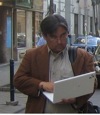On futures and design
The purpose of this essay is to build on [earlier work done by a significant number of groups at the intersection of design and futures], and describe how the relationship between design and futures could be deepened to the benefit of both communities. A closer collaboration, and even more important a hybrid practice that drew on each, would improve product design, profoundly change the way we interact with the future, and create the tools to deal with some of the most critical problems of the 21st century.
I approach this from two directions. First, I describe how design can improve futures. In particular, I argue, research techniques developed by designers– particularly their close attention to human-device interaction– could sharpen thinking about, and forecasting of, the future of technology. Second, I describe the contribution futures can make to design. A combination of new technologies and challenges, I contend, are creating an opportunity to design products that can guide people to make better-informed choices about how they can be used, to reinforce behaviors that help users reach long-term goals, and to create a heightened awareness of the future.
This could have profound implications for futures. It would shift the profession from one that communicates through texts, mainly influences leaders and elites, and influences strategic processes, to one that communicates through things, influences large number of people, and informs everyday decision-making. But this is an essential transformation, as it would give us the ability to help solve the critical problems of the 21st century– problems that, I contend, futures as it currently is practiced is ill-equipped to confront.




